Country India Time zone IST (UTC+5:30) | Largest city Delhi Area 1.421 million km² | |
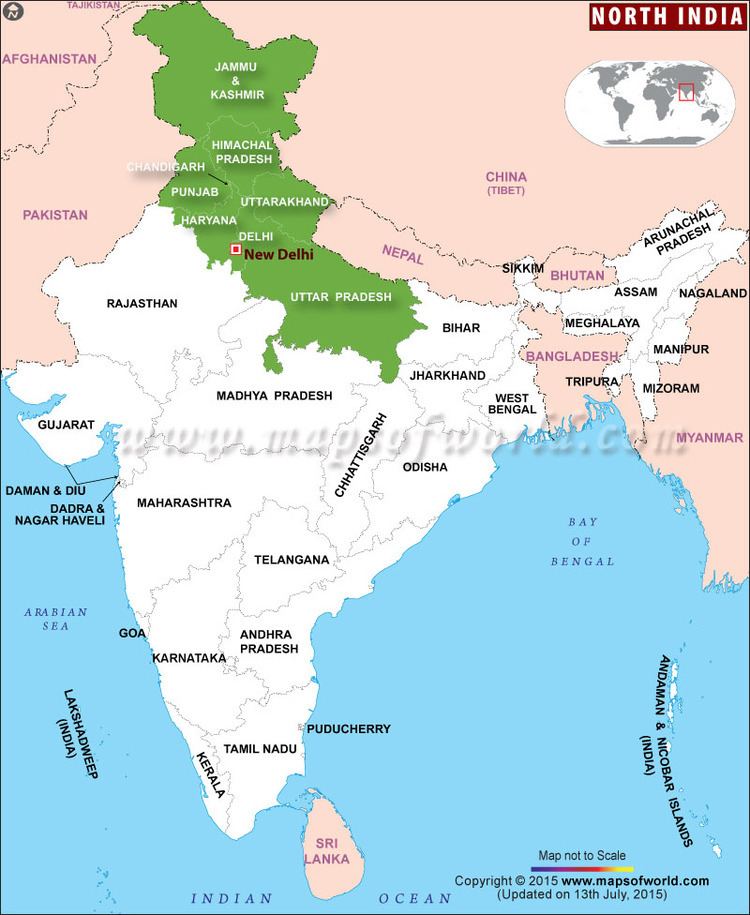 | ||
States and territories HaryanaHimachal PradeshJammu and KashmirPunjabRajasthanUttarakhandUttar PradeshChandigarhDelhi Most populous cities (2011) Haryana:FaridabadGurgaonPanipatAmbalaYamunanagarHimachal Pradesh:ShimlaSolanDharamsalaBaddiNahanJammu and Kashmir:SrinagarJammuAnantnagUdhampurBaramullaPunjab:LudhianaAmritsarJalandharPatialaBathindaRajasthan:JaipurJodhpurKotaBikanerAjmerUttarakhand:DehradunHaridwarRoorkeeHaldwani-KathgodamRudrapurUttar Pradesh:KanpurLucknowGhaziabadAgraVaranasi Official languages HindiEnglishUrduPunjabiKashmiri(Koshur)DogriSanskrit Similar South India, Northeast India, East India Union territories Chandigarh, Ladakh, Delhi, Dadra and Nagar Haveli and Daman and Diu, Jammu and Kashmir, Total area 2,389,300 km2 (922,500 sq mi) Total Population (2011) 912,030,836 Population Density 380/km2 (990/sq mi) Demonyms North Indian Time zone IST (UTC+05:30) Common languages Hindi, Bengali, Marathi, Gujarati, Bhojpuri, Awadhi, Odia, Maithili, Punjabi, Chhattisgarhi, Bagheli, Marwari, Malwi, Kashmiri, Bundeli | ||
South indian vs north indian part 1 standup comedy video by karthik kumar
North India is a loosely defined region consisting of the northern part of India. The dominant geographical features of North India are the Indus-Gangetic Plain and the Himalayas, which demarcate the region from the Tibetan Plateau and Central Asia.
Contents
- South indian vs north indian part 1 standup comedy video by karthik kumar
- What north indians think about south indians
- Definitions
- Government of India definitions
- North of the Vindhyas
- Muslim Central Asian and Afghan impacts as defining influences
- Latitude based definition
- Anecdotal usage
- Geography
- General climate
- Precipitation
- Traditional seasons
- Demographics
- Religion
- Dance
- Languages
- Clothing
- Flora and fauna
- Wildlife parks and reserves
- Nature
- Pilgrimage
- Historical
- Universities
- Economy
- References
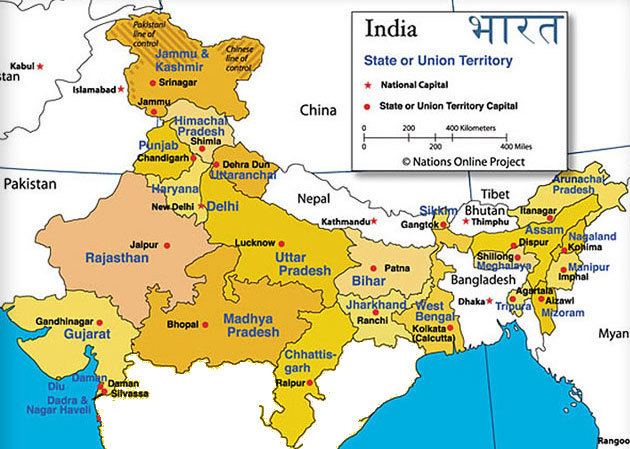
The term North India has varying definitions - the Ministry of Culture defines the North Culture Zone as the states of Chandigarh, Haryana, Himachal Pradesh, Jammu and Kashmir, Punjab, Rajasthan, Uttrakhand whereas the Geological Survey of India includes Uttar Pradesh and Delhi but excludes Rajasthan and Chandigarh. Other states sometimes included are Bihar, Madhya Pradesh, Jharkhand, Gujarat and West Bengal.
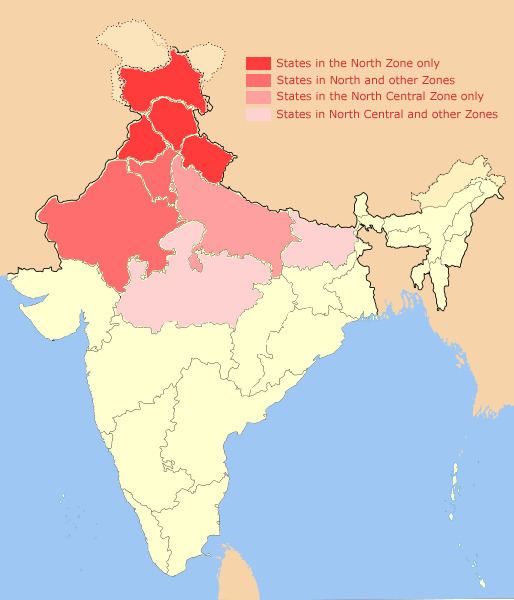
North India has been the historical centre of the Maurya, Gupta, Pala, Harsha, Mughal, Marathas (Scindias), Sur, Sikh and British Indian Empires. It has a diverse culture, and includes the Hindu pilgrimage centers of Char Dham, Haridwar, Varanasi, Ayodhya, Mathura, Allahabad, Vaishno Devi and Pushkar, the Buddhist pilgrimage centers of Sarnath and Kushinagar, the Sikh Golden Temple as well as world heritage sites such as the Nanda Devi Biosphere Reserve, Khajuraho temples, Hill Forts of Rajasthan, Jantar Mantar (Jaipur), Bhimbetka Caves, Sanchi monuments, Qutb Minar, Red Fort, Agra Fort, Fatehpur Sikri and the Taj Mahal.
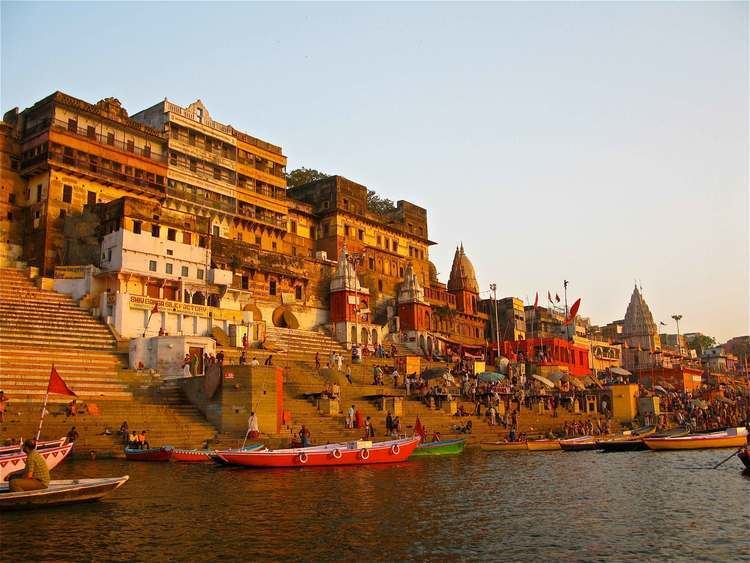
The languages that have official status in one or more of the states and union territories located in North India are Hindi, Sanskrit, Urdu, Punjabi, Kashmiri/Koshur, Dogri and English.
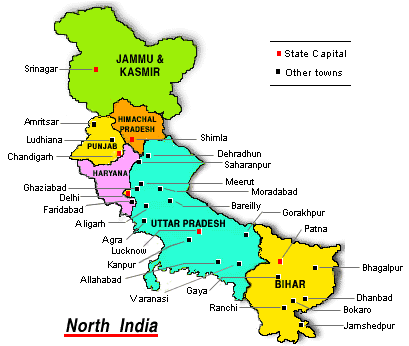
What north indians think about south indians
Definitions
Different authorities and sources define North India differently.
Government of India definitions

The Ministry of Culture defined the North Culture Zone as the states of Union Territory of Chandigarh, Haryana, Himachal Pradesh, Jammu and Kashmir, Punjab, Rajasthan, Uttrakhand, and established a Cultural Centre at Patiala in Punjab.
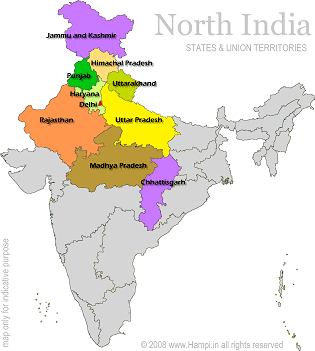
In contrast, the Geological Survey of India (part of the Ministry of Mines) included Uttar Pradesh and Delhi in its Northern Region, but excluded Rajasthan and Chandigarh, with a regional headquarters in Lucknow.
"North of the Vindhyas"
One traditional, and now obsolete, demarcation between Northern and Southern India is the Vindhya mountain range, which has sometimes formed a border during periods of imperial expansion in India, such as the one ruled by the Gupta emperor Samudragupta. The Vindhyas also find mention in the narrative of Rishi Agastya as a dividing feature between North and South India. The Manusmṛti also describes the southern limit of Aryavarta (a classical, and also now obsolete, term for parts of North India) as being defined by the Vindhya range.
Muslim, Central Asian and Afghan impacts as defining influences
Several sources consider sizable Muslim populations and deep-seated Islamic, Central Asian and Afghan influences to be defining characteristics of North Indian culture, both linguistically and culturally. Some of these influences are pre-Islamic, such as the Bactrian-originated Kushan Empire (modern day Afghanistan) that maintained twin capitals in Mathura (now in Uttar Pradesh) and Peshawar (in the present-day Pakistani Khyber Pakhtunkhwa province), as well as the Hun confederacies that periodically asserted their rule over large parts of North India.
Latitude-based definition
The Tropic of Cancer, which divides the temperate zone from the tropical zone in the Northern Hemisphere, runs through India, and could theoretically be regarded as a geographical dividing line in the country. North Indian states which are entirely above the Tropic of Cancer are Jammu and Kashmir, Himachal Pradesh, Punjab, Haryana, Delhi, Uttarakhand, Uttar Pradesh and Bihar.
Anecdotal usage
The term "North Indian" is sometimes used to describe people from Uttar Pradesh and Bihar, often using the term bhaiya (which literally means 'elder brother') in a derogatory sense, though some press reports have contradicted this. In Punjab, people from the same region (Uttar Pradesh and Bihar) are often referred to as Purabias, or Easterners. Some publications of the Government of Bihar place that state in the eastern part of India as well. Within Uttar Pradesh itself, "the cultural divide between the east and the west is considerable, with the purabiyas (easterners) often being clubbed with Biharis in the perception of the westerners."
Geography
North India lies mainly on continental India, north of peninsular India. Towards its north are the Himalayas which define the boundary between the Indian subcontinent and the Tibetan plateau. To its west is the Thar desert, shared between North India and Pakistan and the Aravalli Range, beyond which lies the state of Gujarat. The Vindhya mountains are, in some interpretations, taken to be the southern boundary of North India.
The predominant geographical features of North India are:
The state of Madhya Pradesh has large areas under forest cover, as do Himachal Pradesh, Uttarakhand and Chhattisgarh.
General climate
North India lies mainly in the north temperate zone of the Earth. Though cool or cold winters, hot summers and moderate monsoons are the general pattern. North India is one of the most climatically diverse regions on Earth. During summer, the temperature often rises above 35 °C across much of the Indo-Gangetic plain, reaching as high as 60 °C in the Thar desert, Rajasthan and up to 49 in Delhi. During winter, the lowest temperature on the plains dips to below 5 °C, and below the freezing point in some states. Heavy to moderate snowfall occurs in Himachal Pradesh, J&K and Uttarakhand. Much of North India is notorious for heavy fog during winters.
Extreme temperatures among inhabited regions have ranged from −45 °C (−49 °F) in Dras, Jammu and Kashmir to 50.6 °C (123 °F) in Alwar, Rajasthan. Dras is claimed to be the second-coldest inhabited place on the planet (after Siberia), with a recorded low of -60 °C.
Precipitation
The region receives rain and snow precipitation through two primary weather patterns: the Indian Monsoon and the Western Disturbances. The Monsoon carries moisture northwards from the Indian Ocean, occurs in late summer and is important to the Kharif or autumn harvest. Western Disturbances, on the other hand, are an extratropical weather phenomenon that carry moisture eastwards from the Mediterranean Sea, the Caspian Sea and the Atlantic Ocean. They primarily occur during the winter season and are critically important for the Rabi or spring harvest, which includes the main staple over much of North India, wheat. The states of Jammu and Kashmir, Himachal Pradesh and Uttarakhand receive sustained snowfall in winter months.
Traditional seasons
Northern Indian tradition recognises six distinct seasons in the region: summer (grishma or garmi, May–June), rainy (varsha, July–August), cool (sharad, September–October, sometimes thought of as 'early autumn'), autumn (hemant, November–December, also called patjhar, lit. leaf-fall), winter (shishir or sardi, January–February) and spring (vasant, March–April). The literature, poetry and folklore of the region uses references to these six seasons quite extensively and has done so since ancient times when Sanskrit was prevalent. In the mountainous areas, sometimes the winter is further divided into "big winter" (e.g. Kashmiri chillai kalaan) and "little winter" (chillai khurd).
Demographics
The people of North India are predominantly of the Indo-Aryan ethno linguistic branch, and include various ethnic groups such as Brahmins, Rajputs, Banias, Jats, Ahirs, Gurjars, Kolis, Khatris, Kambojs and Dalits.
Religion
Hinduism is the dominant religion in North India. Other religions practiced by various ethnic communities include Islam, Sikhism, Jainism, Zoroastrianism, Judaism, Bahá'í, Christianity, and Buddhism. The states of Uttarakhand, Rajasthan, Haryana, Madhya Pradesh and Himachal Pradesh are overwhelmingly Hindu. The states of Uttar Pradesh and Bihar have Hindu majorities with a significantly large minority of Muslims; the combined Muslim population of these two states surpasses many of the biggest Islamic nations. Jammu and Kashmir is the only state in India with a majority Muslim population, while Punjab is the only state with a majority Sikh population.
Dance
Dance of North India too has diverse folk and classical forms. Among the well-known folk dances are the bhangra of the Punjab, and rouf and bhand pather of Kashmir. Main dance forms, many with narrative forms and mythological elements, have been accorded classical dance status by India's National Academy of Music, Dance, and Drama such as kathak of Uttar Pradesh.
Languages
Linguistically, North India is dominated by Indo-Aryan languages, although subregions of Northern Dravidian languages, Tibeto-Burman languages (such as Himachal's Lahauli language) and Austroasiatic languages (such as Munda) exist throughout the region. It is in this region, or its proximity, that Sanskrit and the various Prakrits are thought to have evolved. Indo-Aryan languages native to North India include the Hindustani lingua franca (including both its Hindi and Urdu registers), a wide range of western and eastern Hindi dialects, Awadhi, Rajasthani languages (Marwari, Mewari, Shekhawati, Malwi, Bagri), Haryanvi, Bihari languages (Bhojpuri, Magadhi, Maithili and Angika), Pahari, Kumaoni, Garhwali, Punjabi, Kashmiri, Haryanavi and other languages. The subregion where Hindi languages are widely spoken (as either primary or secondary languages) is sometimes called the Hindi Heartland or the Hindi Belt, and is loosely defined.
Small speaker populations of two language isolates (Nihali and Burushaski), which are not known to be rooted in any other language families, also exist in North India.
Clothing
Each state of North India has its own regional forms of clothing:
- Jammu: Kurta/Dogri suthan and kurta/churidar pajama and kurta.
- Kashmir: Phiran and poots.
- Himachal Pradesh: Shalwar kameez, Kurta, Churidar, Dhoti and angarkha.
- Punjab/Haryana: Salwar (Punjabi) Suit, Patiala salwar, Punjabi Tamba and Kurta, Phulkari, Punjabi Ghagra
- Uttrakhand: Rangwali Phichora
Flora and fauna
North Indian vegetation is predominantly deciduous and coniferous. Of the deciduous trees, sal, teak, walnut, sheesham (Indian rosewood) and poplar are some which are important commercially. The Western Himalayan region abounds in chir, pine, deodar (Himalayan cedar), blue pine, spruce, various firs, birch and junipers. The birch, especially, has historical significance in Indian culture due to the extensive use of birch paper (Sanskrit: bhurja patra) as parchment for many ancient Indian texts. The Eastern Himalayan region consists of oaks, laurels, maples, rhododendrons, alder, birch and dwarf willows. Reflecting the diverse climatic zones and terrain contained in the region, the floral variety is extensive and ranges from Alpine to temperate thorn, coniferous to evergreen, and thick tropical jungles to cool temperate woods.
There are around 500 varieties of mammals, 2000 species of birds, 30,000 types of insects and a wide variety of fish, amphibians and reptiles in the region. Animal species in North India include elephant, tiger, leopard, snow leopard, sambar (Asiatic stag), chital (spotted deer), hangul (red deer), hog deer, chinkara (Indian gazelle), blackbuck, nilgai (blue bull antelope), porcupine, wild boar, Indian fox, Tibetan sand fox, rhesus monkey, langur, jungle cat, hyena, jackal, black bear, Himalayan brown bear, sloth bear, and the endangered caracal.
Reptiles are represented by a large number of snake and lizard species, as well as the ghariyal and crocodiles. Venomous snakes found in the region include king cobra and krait. Various scorpion, spider and insect species include the commercially useful honeybees, silkworms and lac insects. The strikingly coloured bir bahuti is also found in this region.
The region has a wide variety of birds, including peafowl, parrots, and thousands of immigrant birds, such as the Siberian crane. Other birds include pheasants, geese, ducks, mynahs, parakeets, pigeons, cranes (including the celebrated sarus crane), and hornbills. great pied hornbill, Pallas's fishing eagle, grey-headed fishing eagle, red-thighed falconet are found in the Himalayan areas. Other birds found here are tawny fish owl, scale-bellied woodpecker, red-breasted parakeet, Himalayan swiftlet, stork-billed kingfisher and Himalayan or white-tailed rubythroat.
Wildlife parks and reserves
Important national parks and tiger reserves of North India include -
Corbett National Park: It was established in 1936 as Hailey National Park along the banks of the Ramganga River. It is India's first National Park, and was designated a Project Tiger Reserve in 1973. Situated in Nainital district of Uttarakhand, the park acts as a protected area for the critically endangered Bengal tiger of India. Cradled in the foothills of the Himalayas, it comprises a total area of 500 km2 out of which 350 km2 is core reserve. This park is known not only for its rich and varied wildlife but also for its scenic beauty.
Nanda Devi National Park and Valley of Flowers National Park: Located in West Himalaya, in the state of Uttarakhand, these two national parks constitute a biosphere reserve that is in the UNESCO World Network of Biosphere Reserves since 2004. The Valley of Flowers is known for its meadows of endemic alpine flowers and the variety of flora, this richly diverse area is also home to rare and endangered animals.
Dachigam National Park: Dachigam is a higher altitude national reserve in the state of Jammu and Kashmir that ranges from 5,500 to 14,000 feet above sea level. It is home to the hangul (a red deer species, also called the Kashmir stag).
Great Himalayan National Park: This park is located in Himachal Pradesh and ranges in altitude from 5,000 to 17,500 feet. Wildlife resident here includes the snow leopard, the Himalayan brown bear and the musk deer.
Desert National Park: Located in Rajasthan, this national reserve features extensive sand dunes and dry salt lakes. Wildlife unique to the region includes the desert fox and the great Indian bustard.
Kanha National Park: The sal and bamboo forests, grassy meadows and ravines of Kanha were the setting for Rudyard Kipling's collection of stories, "The Jungle Book". The Kanha National Park in Madhya Pradesh came into being in 1955 and forms the core of the Kanha Tiger Reserve, created in 1974 under Project Tiger.
Vikramshila Gangetic Dolphin Sanctuary: Located in the state of Bihar, it is the only protected zone for the endangered Ganges and Indus river dolphin.
Bharatpur Bird Sanctuary: It is one of the finest bird parks in the world, it is a reserve that offers protection to faunal species as well. Nesting indigenous water birds as well as migratory water birds and waterside birds, this sanctuary is also inhabited by sambar, chital, nilgai and boar.
Dudhwa National Park: It covers an area of 500 km2 along the Indo-Nepal border in Lakhimpur Kheri district of Uttar Pradesh, is best known for the barasingha or swamp deer. The grasslands and woodlands of this park, consist mainly of sal forests. The barasingha is found in the southwest and southeast regions of the park. Among the big cats, tigers abound at Dudhwa. There are also a few leopards. The other animals found in large numbers, are the Indian rhinoceros, elephant, jungle cats, leopard cats, fishing cats, jackals, civets, sloth bears, sambar, otters, crocodiles and chital.
Ranthambhore National Park: It spans an area of 400 km2 with an estimated head count of thirty two tigers is perhaps India’s finest example of Project Tiger, a conservation effort started by the government in an attempt to save the dwindling number of tigers in India. Situated near the small town of Sawai Madhopur it boasts of variety of plant and animal species of North India.
Kalesar National Park: Kalesar is a sal forest in the Shivalik Hills of eastern Haryana state. Primarily known for birds, it also contains a small number of tigers and panthers.
Nature
The Indian Himalayas, the Thar desert and the Indo-Gangetic plain dominate the natural scenery of North India. The region encompasses several of the most highly regarded hill destinations of India such as Srinagar, Shimla, Manali, Nainital, Mussoorie, Kausani and Mount Abu. Several spots in the states of Uttarakhand and Himachal Pradesh provide panoramic views of the snow-clad Himalayan range. The Himalayan region also provides ample opportunity for adventure sports such as mountaineering, trekking, river rafting and skiing. Camel or jeep safaris of the Thar desert are also popular in the state of Rajasthan. North India includes several national parks such as the Nanda Devi Biosphere Reserve, Jim Corbett National Park, Keoladeo National Park and Ranthambore National Park.
Pilgrimage
North India encompasses several of the holiest pilgrimage centers of Hinduism (Varanasi, Haridwar, Allahabad, Char Dham, Vaishno Devi, Rishikesh, Ayodhya, Mathura/Vrindavan, Pushkar, Prayag and seven of the twelve Jyotirlinga sites), the most sacred destinations of Buddhism (Bodh Gaya, Sarnath and Kushinagar), the most regarded pilgrimage centers of Sikhism (Amritsar and Hemkund) and some of the highly regarded destinations in Sufi Islam (Ajmer and Delhi). The largest Hindu temple, Akshardham Temple, the largest Buddhist temple in India, Mahabodhi, the largest mosque in India, Jama Masjid, and the largest Sikh shrine, Golden Temple, are all in this region.
Historical
North India includes some highly regarded historical, architectural and archaeological treasures of India. The Taj Mahal, an immense mausoleum of white marble in Agra, is one of the universally admired buildings of world heritage. Besides Agra, Fatehpur Sikri and Delhi also carry some great exhibits from the Mughal architecture. Gwalior has some rich cultural sites. Gwalior Fort, Sun Temple which was made by Birla group. Also Jai vilas palace shows maharaja culture. Lucknow has the greatest mix of Hindu and Muslim cultures in India. Kanpur reflects excellent British architecture with monuments like-Edward Hall, Police Quarters, Cutchery Cemetery etc. Khajuraho temples constitute another famous world heritage site. The state of Rajasthan is known for exquisite palaces and forts of the Rajput clans. Historical sites and architecture from the ancient and medieval Hindu and Buddhist periods of Indian history, such as Jageshwar, Deogarh and Sanchi, as well as sites from the bronze age Indus Valley Civilization, such as Manda and Alamgirpur, can be found scattered throughout northern India. Varanasi, on the banks of the River Ganga, is considered one of the oldest continuously inhabited cities in the world and the oldest in India. Bhimbetka is an archaeological site of the Paleolithic era, exhibiting the earliest traces of human life on the Indian subcontinent.
Universities
North India has several universities, including
and many more. The Indian Institute of Technology, National Institute of Technology and Indian Institute of Management have campuses in several cities of North India such as Delhi, Kanpur, Roorkee, Varanasi, Lucknow, Kashipur, Indore and Patna. One of the first great universities in recorded history, the Nalanda University, is in the state of Bihar. There has been plans for revival of this ancient university, including an effort by a multinational consortium led by Singapore, China, India and Japan.
Economy
The economy of North India is predominantly agrarian, but is changing fast with rapid economic growth that has ranged above 8% annually. Several parts of North India have prospered as a consequence of the Green Revolution, including Punjab, Haryana and Western Uttar Pradesh, and have experienced both economic and social development. The eastern areas of East Uttar Pradesh, however, have lagged and the resulting disparity has contributed to a demand for separate statehood in West Uttar Pradesh (the Harit Pradesh movement). Bihar's economy has been the fastest growing state economy in India, higher than all the Indian states including Gujarat.
The birth rate in North India significantly surpasses that of other regions in the country, potentially exacerbating poverty and its associated challenges. Unemployment remains a pressing issue in North India, partly due to the scarcity of advanced technological industries. This shortage of job opportunities has prompted both unskilled and skilled workers to migrate to Southern India or abroad in search of employment. The technological surge in Southern India over the last thirty years has offered numerous job opportunities to individuals from the north, enabling them to pursue prosperous lives in the southern cities.
The states with the highest GDP per capita in North India are Delhi, Haryana, Uttarakhand and Himachal Pradesh. The National Capital Region of Delhi has emerged as an economic power house with rapid industrial growth along with adjoining areas of Uttar Pradesh, Haryana and Rajasthan. Chandigarh has the highest per-capita State Domestic Product (SDP) of any Indian union territory.
